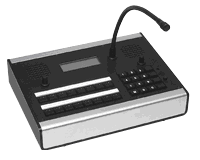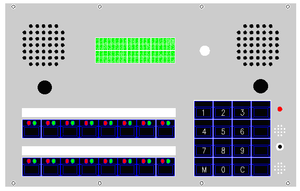MCS station
From Zenitel Wiki
Features
Special Control Room Station Features
The Control Room Stations are designed to provide good control and easy operation in situations where many calls are directed to one central point, for monitoring and talking into conferences and monitoring of other activities in the system:
- Access to more than 10 Single-touch keys on one station for quick and easy handling of calls to and from a large number of stations/features.
- - 20 Single-touch keys on an MCS station
- Call priorities shown by display, LED and buzzer indication (programmable).
- Noise-canceling goose-neck microphone
- Headset option.
Multiconference Features
- Mixing of audio from up to six simplex conferences in one loudspeaker.
- Easy programming of control keys for the multiconference features, like TalkBack key and Activate key.
- Special Multiconference station MCS with two loudspeakers for mixing of audio and 20 single-touch keys giving enhanced control when using the Multiconference features.
Note that any station with display and single-touch keys can be used but with a somewhat reduced function pattern compared to the MCS station.
System Features Useful on a Control Room Station
- Display information giving names and numbers of call-in points.
- Programmable function keys for station transfer, program selection, etc.
- Parallel service provides flexibility in manning of control stations.
- Off-hook time-out. The station goes on-hook and becomes free after 25 seconds (programmable) when not in conversation.
- Line monitoring provides automatic checking of stations’ lines, reporting to the control room station as well as to a central service point (programmable) on line failure.
Number of MCS Stations in One Exchange
- The MCS station can be connected to any type of AlphaCom exchanges. The maximum number of MCS stations in one exchange is set to 25, considering system load due to LED updates on all stations simultaneously.
Additional Information: MCS can not be used with TouchLine or TouchLine Compact exchanges.
Feature Description
Calling a station
When the single-touch (DAK) keys have been programmed, you just press the key to activate the call or feature programmed on the station. To cancel the call, press the C-key. If you hold down the key, it works as an M-key. When it is released, the M-key state is terminated, and the ordinary M-key must be used later during the conversation.
Additional Information: The M-key/C-key function for the single-touch keys is intended for announcements: Press the key, keep it down while speaking and release it to cancel.
Simplex Conference
A simplex conference has one speaker and many listeners. There is no upper limit; all stations in an exchange can be members of one conference and thus listen to the same source. This concept is also called program conference, as it uses the same hardware as audio program distribution. You can speak into the conference from one station at a time simply by pressing the M-key while listening to a conference. To interface e.g. to mobile radio systems, each conference can have a default member, which also can be default speaker. The default member is forced into conference when the first normal member joins. If it’s the default speaker, it will feed the conference without any active use of M-key. When a normal member uses it’s M-key, the conference is fed temporarily from that station, but returns to the default speaker after the M-key has been released again. The AlphaCom has 50 simplex conferences. One station can be member of one conference at a time. A station can join the conference by dialing 82xx, or one or more stations can have access to remote setup to station/group by dialing 75 + station/group + 82xx. A station leaves a conference by dialing 8200.
Simplex Multiconference
A single station can be member of many Simplex Conferences at the same time. To be able to use the full functionality, a dedicated MCS station is required. It has two speakers; each can be a mix of up to 6 conferences. In addition, it has a dedicated single-keyboard with 20 Single-touch (DAK) keys that can be programmed with the special keys used to control the multiconference features. The MCS station is basically a standard intercom station, i.e. in addition to the multiconference feature, full AlphaCom functionality is available. Note that any station with display and single-touch keys can be used for the Multiconference feature but with a somewhat reduced function pattern compared to the MCS station.
Single-touch Keys for Multiconference Control
Before you can use the station, you must program the keys Select (SEL), Activate (ACT), Priority (PRI) and the off key.
- TalkBack
- This key is used when you want to talk into the conferences. As many conferences are monitored at the same time, each conference has its own TalkBack key. During commissioning you link an AGA board/port to the station’s TalkBack keys.
- SELect
- The Select key is used when you assign a conference to a TalkBack key. Select modifies the TalkBack key’s conference parameter.
- ACTivate
- This key is used when you activate monitoring of a conference. When the TalkBack key is pressed, this station goes in or out of the corresponding simplex conference depending on the previous state. Audio is controlled immediately on/off. Several TalkBack keys can be pressed during one Activate session, which is terminated by another press of the Activate key.
- PRIority
- The Priority key is a variant of activate and one channel is forced active, all others off.
- OFF
- The DeActivateAll is a variant of activate and all channels are switched off.
Station Description
The Multiconference Station MCS
Station Controls
- The station is equipped with:
- 16 single-touch keys each with a green and a red LED.
- 4 single-touch keys without LEDs.
- Two loudspeakers, each can mix the audio of 6 simplex conferences.
- The speakers are 45-ohm speakers.
- External loudspeakers may be added, minimum 8 ohm.
- 2 Volume adjustment potentiometers, one for each loudspeaker.
- LCD display with backlight.
- The LCD display has 4 lines with 20 characters on each.
- 0-9 digit keypad.
- M-key for manual control of speech direction.
- C-key for canceling calls.
- Noise-canceling gooseneck microphone.
- Microphone LED.
- Buzzer.
- Relay output (for external buzzer or general RCO).
The building blocks The Multiconference Station (MCS) is presented to the user as an integrated exchange feature, but it actually consist of several independent parts. You should understand the properties of the different building blocks, as it will make configuration easier, and will also allow you to see possible variant applications.
- MCS station. Other station types with display and single-touch keys can also be used, but the MCS station is designed to use all control possibilities for a multiconference.
- AGA board. The exchange must be equipped with minimum one AGA board to use the Multiconference features. The ports on the AGA board used for connection to MCS are set in conference mode.
- Software features. You must have AMC software 07.60 or later to use the Multiconference features.


